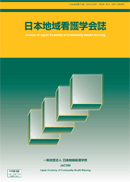Volume 8, Issue 1
Displaying 1-12 of 12 articles from this issue
- |<
- <
- 1
- >
- >|
-
Article type: Article
2005Volume 8Issue 1 Pages 5-12
Published: September 15, 2005
Released on J-STAGE: April 20, 2017
Download PDF (1329K) -
Article type: Article
2005Volume 8Issue 1 Pages 13-23
Published: September 15, 2005
Released on J-STAGE: April 20, 2017
Download PDF (1530K) -
Article type: Article
2005Volume 8Issue 1 Pages 24-30
Published: September 15, 2005
Released on J-STAGE: April 20, 2017
Download PDF (1072K) -
Article type: Article
2005Volume 8Issue 1 Pages 31-40
Published: September 15, 2005
Released on J-STAGE: April 20, 2017
Download PDF (1450K) -
Article type: Article
2005Volume 8Issue 1 Pages 41-45
Published: September 15, 2005
Released on J-STAGE: April 20, 2017
Download PDF (919K) -
Article type: Article
2005Volume 8Issue 1 Pages 46-52
Published: September 15, 2005
Released on J-STAGE: April 20, 2017
Download PDF (1099K) -
Article type: Article
2005Volume 8Issue 1 Pages 53-58
Published: September 15, 2005
Released on J-STAGE: April 20, 2017
Download PDF (949K) -
Article type: Article
2005Volume 8Issue 1 Pages 59-64
Published: September 15, 2005
Released on J-STAGE: April 20, 2017
Download PDF (1127K) -
Article type: Article
2005Volume 8Issue 1 Pages 65-72
Published: September 15, 2005
Released on J-STAGE: April 20, 2017
Download PDF (1335K) -
Article type: Article
2005Volume 8Issue 1 Pages 73-80
Published: September 15, 2005
Released on J-STAGE: April 20, 2017
Download PDF (1189K) -
Article type: Article
2005Volume 8Issue 1 Pages 81-87
Published: September 15, 2005
Released on J-STAGE: April 20, 2017
Download PDF (1151K) -
Article type: Article
2005Volume 8Issue 1 Pages 88-93
Published: September 15, 2005
Released on J-STAGE: April 20, 2017
Download PDF (975K)
- |<
- <
- 1
- >
- >|
